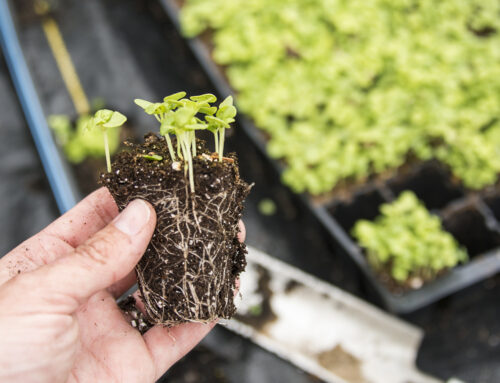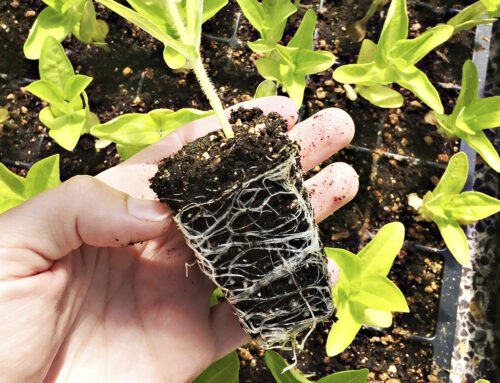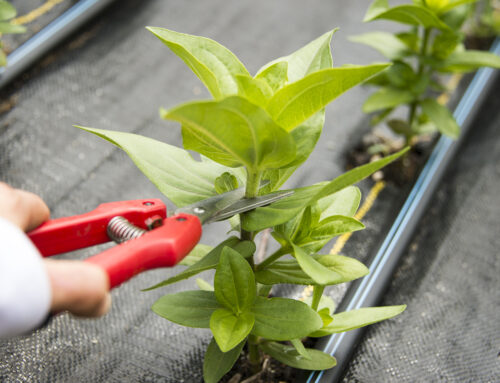Plant spacing and sow schedule, these are the nitty-gritty elements of garden planning. It’s incredibly tempting to jump into a massive seed sowing extravaganza right now. Trust me, I get it. What you have to remember is, it’s still February! And unless you have greenhouse space, and the room to pot them on when your seedlings get too big for their plugs, wait. Daily seed arrivals are seductive. Instead of immediate sowing, satisfy those itchy garden fingers by creating your sow schedule and figuring out your plant spacing.

Determining when to start each variety and how many of each you need is vital for your garden. Personally I love a good spreadsheet, so this is one of the fun parts for me.
No worries if planning isn’t your bag. I’m here to help you navigate the often over-complicated sow schedule and figure out how many seedling to grow based on plant spacing.
Before we begin I need to share with you something … I’m an intensive planter. This means that I harvest my garden regularly throughout the growing season. Therefore, I can plant my veggies, herbs and flowers a bit closer than recommended. Going forward you need to keep in mind that my plant spacing chart will be based on this assumption.
First, Identify your Frost Date
Pinpoint your average last spring frost date using your zip code HERE, or the Old Farmer’s Almanac’s Frost-Date Calculator. Simply input your zip code, and mark down your last spring frost. Mine is May 5th though May 9th based on the above calculators.
If you’re interested in the details about your frost date and hardiness zone, check out PlantMaps. Again, enter your zip code and voilá! There it is, all the information you could ever want about your hardiness zone, local garden data and climate is there. I’m a zone 5b.
The Sow Schedule.
There’s no need to overcomplicate this. A sow schedule tells you which dates are appropriate to start your seeds indoors, and when it’s safe to plant out in the garden.
When you pop over to the Johnny’s site (where I source many of my own seeds) its easy to get lost in all the luscious seeds, however they also offer fabulous resources. Their Seed Starting Date Calculator is wonderfully easy to use and highly useful. Enter in your frost free date, and out pops the date to start your seeds, and when to plant out in the garden. It doesn’t get much simpler than that! Print it out, keep it handy. As you start your seeds, mark off which you sowed and the actual date you planted them. This will be good information for next year in case you need to modify your planting scheme.

Johnny’s Selected Seeds has several other amazing resources—all for free—on their Planning Tools & Calculators page. Particularly nifty are their Succession-Planting Calculator, the Target Harvest Date Calculator and Fall-Harvest Planting Calculator. These are all downloadable in excel (or convertible to numbers) spreadsheets.
The succession calculator is helpful if you plan to plant multiple waves of veggies, herbs or flowers. Lettuce, sunflowers and basil are some of the plants I find this useful for. If you’re planing to grow flowers (or herbs or vegetables) for a specific event, the Target Harvest calculator is essential. First time—and experienced—gardeners may find the fall harvest calculator a practical assistant to determining when to plant that last series of cool-weather crops.
At A Glance
When I go out to the greenhouse to sow seeds, I like to know exactly what I’m going to plant that day. So, to better organize the information, I created a general At-A-Glance Sowing Schedule. The chart is based on your last spring frost date, and divided into seed sowing windows. Each sowing window indicates how early the plants listed beneath need to be sown before the last frost. Keep a paper copy handy by downloading and printing the free PDF HERE!

Plant Spacing
All seed packets have plant spacing information on them. If you ripped, or lost your packet, you can look up the seed online. Most companies include this information under “Growing Information” on their seed pages.
Alternatively, if you know you’ll be out in your garden harvesting multiple time a week, you can plant your seedlings closer than packet recommendations. This practice is known as intensive planting. The benefit is MORE plants in the same space!

Garden planning is all strategy. When planning my garden, if possible, I design each bed to have one, consistent plant spacing throughout. Rectangular beds with the jigged rows allow for maximum spacing. Layouts like this make every plant equally spaced from each other. For example, in a standard 4′ x 8′ bed with 12″ spacing, the plan would look like this:
 Remember from earlier when I mentioned I’m an intense planter? This is what I meant. I’m all about squeezing as many plants as possible into the garden footprint. The flip side is you need to be out there harvesting regularly during the growing season, which is a no-brainer for me (I mean, I’m a gardener who loves to be out, harvesting delicious and gorgeous goodies from her garden).
Remember from earlier when I mentioned I’m an intense planter? This is what I meant. I’m all about squeezing as many plants as possible into the garden footprint. The flip side is you need to be out there harvesting regularly during the growing season, which is a no-brainer for me (I mean, I’m a gardener who loves to be out, harvesting delicious and gorgeous goodies from her garden).
Every plant in the above 4′ x 8′ bed is equally spaced, 12″ apart from one another. In it, I can fit twenty-three plants in a single bed! You can see how each bed having only one spacing scheme makes it easy to plot out on paper AND use landscape fabric as mulch.
Mulch Sidenote:
Mulch is absolutely crucial to gardening. Besides keeping your plants weed free—the importance of which cannot be overstated, mulch maintains cool root temperatures, conserves moisture, protects plants from soil-borne disease and can even be attractive. Organic mulches, seaweed is a particular favorite of mine, does everything a good mulch should do, as well as contain micronutrients which breaks down and improves to your soil’s organic matter content.

Landscape fabric, while not an organic material, its use is considered an organic practice. The fabric acts just like any other mulch, but it can be reused year after year, makes intensive planting look easy, has improved moisture retention and better weed control. Check back in a few weeks when I devote an entire post to mulch. That’s how much I love mulch.
So back to plant spacing…
I find it helpful to have all the plants I want to grow grouped together by spacing length. Nine-inch plant spacing is by far the most common. Below is my Intensive Plant Spacing chart, which I use to determine the layout in my gardens (and on my herb farm). Download the PDF HERE, to print, reference and keep for your records.

Garden Journals
Adjustments are inevitable. Your garden’s microclimate may be different than a friend’s, even just several miles away, so keeping notes of what happens, and when it does, is necessary.
Documenting is so important. You think you’ll remember what you planted, when the seeds germinated, when they got planted out and so on, but these details can get lost if you don’t keep a chronicle of it somewhere.

I used to scribble all my growing notes in a pretty little composition book. However, over time I’ve found it more efficient to make quick notations in the notebooks, then transfer them to a spreadsheet (I did mention my fondness for spreadsheets). A spreadsheet makes finding what I’m looking for so, so, so much easier.
That’s why I’m going to share mine! In addition to keeping a log of all the nuts and bolts gardening in one place, there’s also space for you to make notes of your own. Included in the spreadsheet is the first page of my 2021 chronicle, I hope it gives you an idea of what information I record and document.
Typically I enter in the details of the plants I’m going to grow, then print it out and attach to a clipboard. As the growing season progresses I jot down and record the day I sowed my seeds, how many, when they germinated and all those exciting facts. I keep these spreadsheets and use them when revisiting what worked—and what didn’t. In early winter when outlining next year’s garden, that information makes planning and layout modifications easier. Feel free to clear out my data, and enter your own. You can download my Garden Journal spreadsheet HERE.
(KEY on spreadsheet: DTM = Days to Maturity, DTG = Days to Germination, Succ. = Successions, and TP = Transplanted)
Happy Garden Planning and Plotting!





[…] For more information on plant spacing, check out my post where I dive deep into Plant Spacing and Sow Schedule in the Garden! […]
[…] spacing when you know you’ll be harvesting regularly. I have a whole entire post dedicated to Intensive Plant Spacing and Sowing (check it out […]